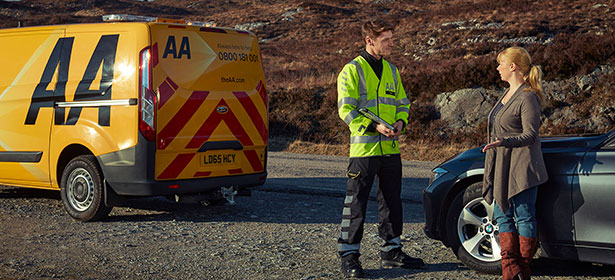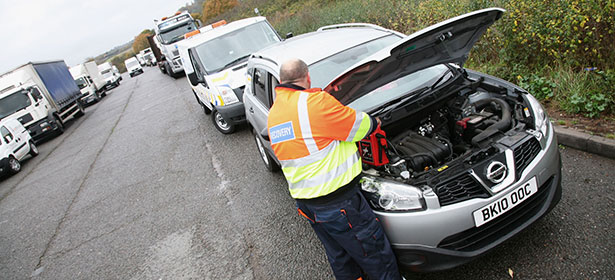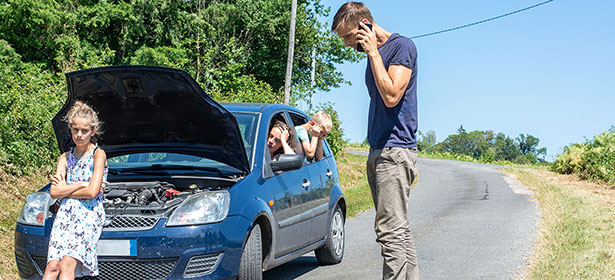
Compare car insurance deals
Check Which? insurance ratings and compare deals using the service provided by Confused.com
Get a quote
Getting the right breakdown cover isn't only about finding the best provider. You'll want to be sure you get the right level of cover, without paying more than you need.
For instance, did you know basic roadside assistance often doesn’t cover you within a quarter of a mile of your home? So if your car refuses to start on a frosty winter morning, you may have to pay extra on top of your regular breakdown cover.
Year after year, our research shows that more people called breakdown services to their home than to any other location, so it's vital to get the right level of cover.
Simply want to know which providers are best? We reveal the best car breakdown cover providers
You can get breakdown cover in several forms. Here are the basic types:
The AA, RAC and Green Flag are the biggest and best-known third-party providers. They are independent services with their own network of mechanics. You can buy breakdown cover either directly via their websites or through price comparison sites. Each provider offers various levels of cover to choose from.
If you buy a new car, most manufacturers will include free breakdown cover for a limited period time (usually between one and three years). For instance, if you buy a Honda, you get free three-year breakdown cover from Honda Breakdown Assist; however, the actual service is supplied by a third-party provider (the AA, in the case of Honda).
You can get car breakdown cover bundled in with your packaged bank account or car insurance (see our guide on how to find cheap car insurance).

Check Which? insurance ratings and compare deals using the service provided by Confused.com
Get a quote
We all have different driving habits, and third-party car breakdown providers offer several levels of cover to suit your needs. What the companies call these levels varies, but here are the main four:
A breakdown van will come out to you and will either fix your car at your breakdown location or tow you to the closest garage. Most policies have a recovery limit (the maximum towing distance) of 10-15 miles from the scene of the breakdown.
Bear in mind that if you break down within a quarter of a mile of your home (or a full mile if you're with Autoaid, Axa or Start Rescue), you won't be able to call out your provider (or may have to pay extra) if you only have basic roadside assistance.
While it might be tempting to save money upfront by just getting basic cover, you could have to pay out large sums of money if you break down on your driveway (the most likely location for you to need to call out a breakdown service, according to our latest survey).
If you choose to upgrade your cover from basic to include home assist (also known as 'home start'), it will take 24 hours for any policy to come into effect with most providers.
You and your passengers will get towed to your chosen destination anywhere in the UK (including your home, if you wish), or the closest garage to your destination. If you only have roadside assistance, you'll be towed to a local garage.
If you're travelling on the continent and your car breaks down, you will be covered for most scenarios, as European cover is often very comprehensive. If you don't already have this cover, most UK providers won't be able to offer you any assistance once you're abroad, so make sure you take out European cover before you leave the UK.
If you don't have European cover and break down abroad, you'll be left to organise assistance yourself from a local recovery service and be stuck with towing and repair charges.
Annual and single-trip cover is available from most providers. Most providers offer around 90 days of travel cover in Europe as part of their annual policies, but be sure to check this and whether the country you're travelling to is listed as a covered destination.
Find your perfect next car – see our expert pick of the best cars we've tested

As always, it pays to shop around. You can use our best breakdown cover results to put together a shortlist of companies. Make sure you carefully consider your needs and choose an appropriate level of service.
We also recommend comparing prices online and giving a few providers a call. If you’ve found a cheaper quote elsewhere, speak to your preferred provider and see if it will meet the quote or beat it (take a look at our haggling tips).
The AA, RAC and Green Flag have the largest market share of all the companies we survey, but our results show that others can provide top-quality service – often at a lower price.
If you can afford it, you can cut your costs by paying annually instead of monthly. Some breakdown provider websites default to showing monthly payments, so you may have to specifically select the annual option to see the price difference.
You might find you can save money by getting your breakdown cover as part of another purchase.
Some car insurance policies come with breakdown cover included. However, be sure to check what company is providing the breakdown service and what level of cover it's offering.
All packaged bank accounts we've reviewed offer personal breakdown cover (find out the difference between 'personal' and 'vehicle' cover). Cover levels vary but all packaged bank accounts we reviewed include roadside assistance, home assist and nationwide recovery.
Nationwide FlexPlus is one of our highest-rated packaged bank accounts.
It offers comprehensive UK breakdown cover from the AA that includes roadside assistance, at home recovery, national recovery and onward travel. It's also one of the few packaged accounts to include European cover. You even get worldwide travel insurance with winter sports and mobile phone cover.
Packaged bank accounts come with a monthly fee, so they're not right for everyone. However, if you're planning multiple driving trips in Europe and will make use of the travel and phone insurance, it might save you money over the year.
Discover the best packaged bank accounts.
If you're thinking of selling your car and not replacing it, it's important to check what your chosen provider's refund options are. Similarly, if you're planning on buying a brand new car in the next 12 months, you'll likely get breakdown cover included via the car manufacturer so will want to avoid doubling up on cover.
Question your chosen breakdown provider at renewal time (but before you actually renew) to find out its cancellation/refund conditions.
You typically get a pro-rata refund based on how much time you’ve got left on your current agreement. Sometimes the pro-rata refund also comes with an admin charge. If you’ve made a claim in the year your cover applies to, you might not be entitled to a refund, and some companies don't offer a refund regardless.
There is a 14-day cooling-off period for all new policies. So if you choose to cancel within 14 days of setting up or renewing a policy, you should get a full refund.
Breakdown cover with a car manufacturer is often comprehensive – see our review of the best car manufacturer breakdown services.
As you approach the end of your free breakdown cover period – often coinciding with the end your warranty period – you may want to renew your policy. Some manufacturers will offer breakdown cover for free, if you have your car serviced by an approved dealership. This isn't exclusive to new cars – second-hand cars can also benefit from this offer. Other providers may charge you a fee, but it's often at the same cost or lower than what you'd get through a third party.
Car breakdown companies expect you to haggle. It's generally cheaper for them to keep existing customers than to acquire new ones, so haggling is built into their pricing structures.
In our latest car breakdown survey, we found that an astounding 82% of respondents who haggled with their provider on renewal received a lower quote.
Most people still haggle over the phone, but you can also try live chat (this also means you get to keep a written record of what was said).
We asked ex-salespeople and successful hagglers for their top haggling tips, which include:
To make haggling easier, use our script to boost your chances of getting a better deal from an existing provider.
Wait for the response. It's likely the company will mention that new customers are often offered introductory prices.
Wait and see what the call handler says. If they don't offer to reduce your premium, you can push a little harder.
If you're not happy with the deal you're offered, don't put up with it. There's no sense paying over the odds. Instead, use our research into car breakdown cover companies to help you find a good provider that's rated highly by its customers.

Use our top tips to make sure your breakdown company can go that extra mile.
Assuming you have a smartphone and can get a signal, using your breakdown cover company's app to arrange a call-out has distinct advantages.
The biggest is that it can tell your breakdown provider your exact location. No more describing the lay-by you’re in as ‘by the tree, just after a bridge’.

We’ve had complaints from people who say their vehicle was damaged while being towed and the breakdown company denied responsibility.
You can try to avoid this by taking photos of your broken-down car, just like you would if you'd had an accident. Then, if further damage occurs during the tow, take photos of that as well.
Be careful, though – only take photos if it's safe to do so.
If you have several vehicles, personal cover means you can call out a breakdown service for any car you happen to be in. Most, though not all, providers offer personal cover as a choice when you get a quote. It tends to be more expensive than vehicle-level cover but you usually can add at least one other driver to your policy.
Vehicle cover is the most widely available type of cover and applies to a specific car. You can add between two and five drivers with most policies, so it can be a more suitable option if you share a car with a partner or family members.
While some providers offer unlimited call-outs with their breakdown cover, others will limit the number of times they will assist you if your car breaks down.
We've found basic roadside assistance policies that allow for as few as two or three call-outs per year, while even some comprehensive policies will only provide assistance five times.
Generally included with more comprehensive policies, this covers you for a hire car, overnight accommodation or costs towards taxis and public transport if a breakdown provider can't fix your vehicle straight away. Some providers include this as standard; with others, it's an optional extra.
Putting the wrong type of fuel in your car can cause serious damage to your engine. The system then needs to be drained and flushed, which can cost between £150 and £300. Less than a quarter of the policies we looked at at will cover you for this, and even then you could be charged as much as £225.
If your dog is a frequent passenger in your car, check the breakdown policy's small print before you buy. While most providers say they will still cover you if you break down with a pet on board, transporting the animal will generally be at the discretion of the patrol mechanic who attends.
If the patrol mechanic is unwilling to let your pet into the cab, or there simply isn't enough room, your pet will either need to be secured in your towed vehicle or you may have to organise alternative transport yourself.
If you're driving in Europe, you'll also need to make sure you have the right car insurance and associated documents. Find out more in our guide to international driving permits.

If you’ve got a fairly new car that’s so far provided trouble-free motoring, you may decide to forgo breakdown cover altogether.
You can find out if your car is fault-prone in our guide to the most reliable cars.
In the event that you do need emergency assistance but don't have breakdown cover, all is not lost, as you can call for assistance through a pay-on-use service, but it will cost you. The most basic level of assistance will set you back at least £100, and costs can quickly rack up if you need extra services such as towing.
The few providers that offer this service include the AA, LV Britannia Rescue, RAC and GEM. Some providers offer a lower call-out fee for pay-on-use services to existing policyholders.
Drive smarter and cut costs using our expert advice. Get our Cars newsletter – it's free monthly
Find the right policy for your vehicle using the service provided by Confused.com
Get a quote now